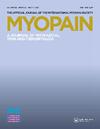Review of: The Phenomenon of Pain by Serge Marchand
引用次数: 1
Abstract
At first glance, The Phenomenon of Pain appears to be a medical textbook. Its initial chapters deftly cover topics of neuroscience and pain in scholarly detail and scope. A closer look reveals that the author, Professor Serge Marchand, PhD, has a more advanced purpose in mind, namely to demonstrate how neurophysiologists and psychologists might benefit from studying the basic tenets of each other’s specialties so that both can more capably treat pain. Dr Marchand notes, ‘‘This approach is quite logical because even if the treatment is ‘psychological,’ knowledge of the neurophysiological mechanisms can only help the therapist to apply it and measure its effects. Similarly, knowledge of factors other than the physiological ones will help the health professional to monitor the patient’s progress and distinguish the effects directly related to the treatment, pharmacological or otherwise, from those related to other internal or external events that may be affecting the patient’’ [pp. 2–3]. He illustrates this point throughout his book, choosing not to concentrate on any one medical condition in detail, offering instead a more general discussion of pain and its treatment. Following detailed, medical chapters on neurophysiology, neurophysiology of pain, and the history/evolution of pain, Dr Marchand introduces the reader to situations where a psychological or societal frame of reference can provide special forms of data or a context in which individuals in pain can be understood. In his chapter on measuring pain, he cautions that, ‘‘. . .it is important to remember that pain is a perception and that physiological measurements reflect nociceptive activity and not necessarily pain’’ and that the ‘‘patient’s assessment is still the standard measurement!’’ [pp. 131–132]. He also discusses in detail many of the concepts and problems inherent in measuring pain from both a physiological and psychological perspective. Not to be missed are later chapters which explore special populations of pain patients. Dr Marchand poignantly describes how in past times the pain perception capabilities of the very young were sometimes grossly underestimated meaning that young infants suffered through painful procedures or illnesses with little or no pain medication. At the other end of the age spectrum, the elderly are particularly vulnerable to the adverse effects of medications, but still need to have their pain addressed. Problems in treating both age groups are difficulties in communication. Also, extremely important in the book is the material on the differences in pain sensitivity and pain tolerance between males and females and between [and within] various racial and ethnic groups. The Phenomenon of Pain is very impressive in all that it covers. It would benefit, though, from a sequel which considers pain not as a single symptom, but one which frequently exists alongside [or in conjunction with] other similarly troublesome, physiological symptoms, such as fatigue, stiffness, brain fog, etc. In addition, it would be useful to consider the various pain conditions that can coexist or overlap. Consider fibromyalgia syndrome, osteoarthritis and myofascial pain, which are a frequent trio that appears together, particularly as aging occurs. [It would be nice to see myofascial pain discussed in more detail, too, as there have been many new developments in the field recently.] And what of patients who take multiple prescription pain medications for more than one condition? All of回顾:马尚的《疼痛现象》
乍一看,《疼痛现象》似乎是一本医学教科书。它的最初章节巧妙地涵盖了神经科学和疼痛的学术细节和范围的主题。仔细一看,作者Serge Marchand教授博士有一个更高级的目的,即展示神经生理学家和心理学家如何从研究彼此专业的基本原则中受益,以便双方都能更有效地治疗疼痛。Marchand博士指出,“这种方法非常合乎逻辑,因为即使治疗是‘心理的’,神经生理机制的知识也只能帮助治疗师应用它并衡量它的效果。同样,了解生理因素以外的其他因素将有助于卫生专业人员监测患者的进展,并将与治疗直接相关的影响(药理学或其他)与可能影响患者的其他内部或外部事件相关的影响区分开来”[第2-3页]。他在书中阐释了这一点,选择不集中在任何一种医疗状况的细节上,而是提供了一个关于疼痛及其治疗的更广泛的讨论。在详细的神经生理学、疼痛的神经生理学和疼痛的历史/演变的医学章节之后,Marchand博士向读者介绍了心理或社会参考框架可以提供特殊形式的数据或可以理解疼痛个体的背景的情况。在他关于测量疼痛的章节中,他警告说,“…重要的是要记住疼痛是一种感知,生理测量反映的是伤害性活动,而不一定是疼痛”,并且“患者的评估仍然是标准的测量!”[第131-132页]。他还详细讨论了从生理和心理角度测量疼痛的许多概念和固有问题。不可错过的是后面的章节,探讨特殊人群的疼痛患者。Marchand博士尖锐地描述了过去幼童的痛觉能力有时是如何被严重低估的,这意味着年幼的婴儿在很少或没有止痛药的情况下经历了痛苦的手术或疾病。在年龄谱的另一端,老年人特别容易受到药物副作用的影响,但他们的疼痛仍然需要得到解决。治疗这两个年龄组的问题是沟通困难。此外,书中非常重要的是关于男性和女性之间以及不同种族和民族群体之间(和内部)疼痛敏感性和疼痛耐受性差异的材料。《疼痛现象》所涵盖的内容令人印象深刻。不过,如果续集不把疼痛视为一种单一症状,而是经常与其他类似的麻烦的生理症状(如疲劳、僵硬、脑雾等)一起存在(或同时存在),它将会受益。此外,考虑可能共存或重叠的各种疼痛状况将是有用的。想想纤维肌痛综合征,骨关节炎和肌筋膜疼痛,这是一个经常出现的三人组,特别是随着年龄的增长。如果能看到肌筋膜疼痛得到更详细的讨论,那就太好了,因为最近在这个领域有了许多新的进展。对于那些服用多种处方止痛药治疗一种以上疾病的患者又会怎样呢?所有的
本文章由计算机程序翻译,如有差异,请以英文原文为准。
求助全文
约1分钟内获得全文
求助全文

 求助内容:
求助内容: 应助结果提醒方式:
应助结果提醒方式:


